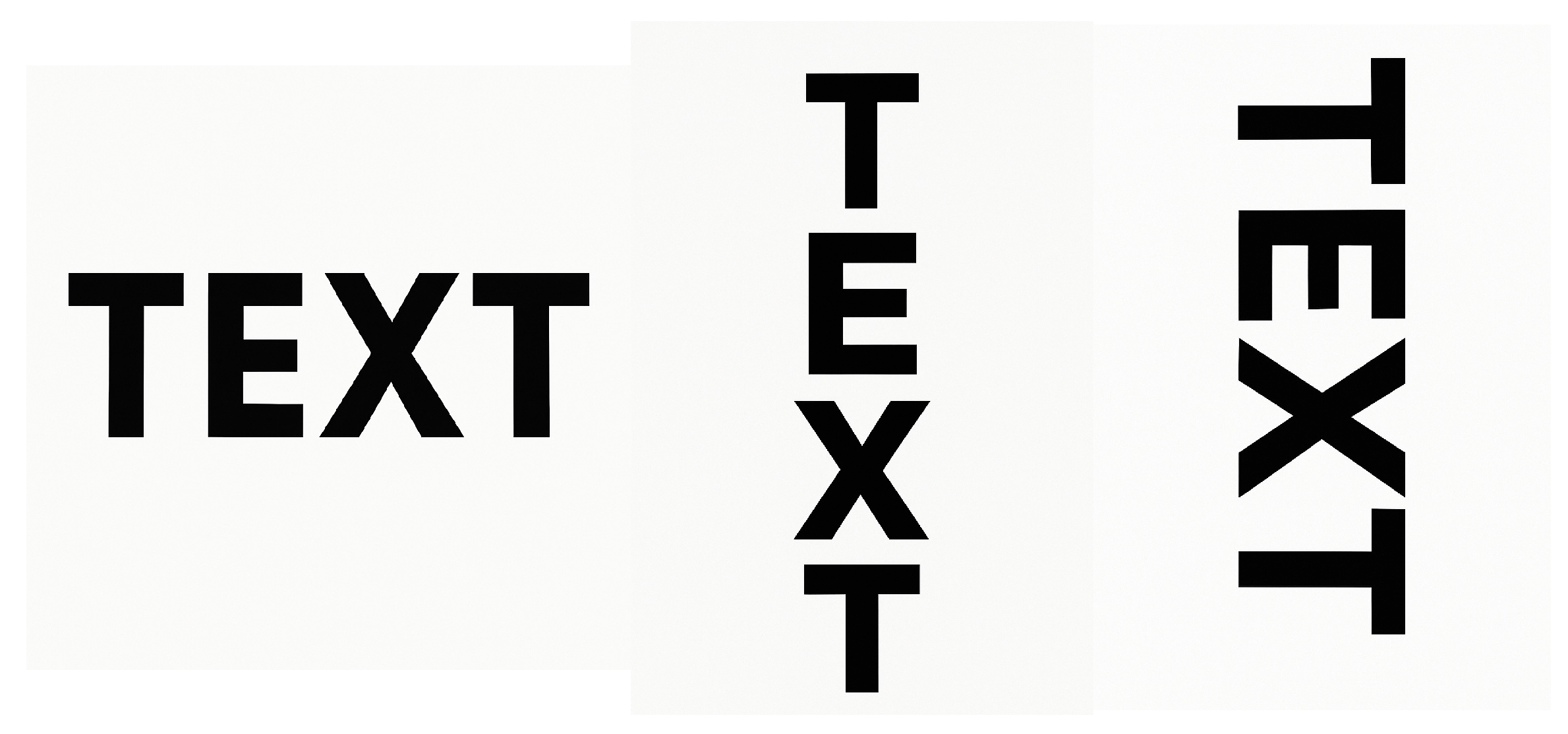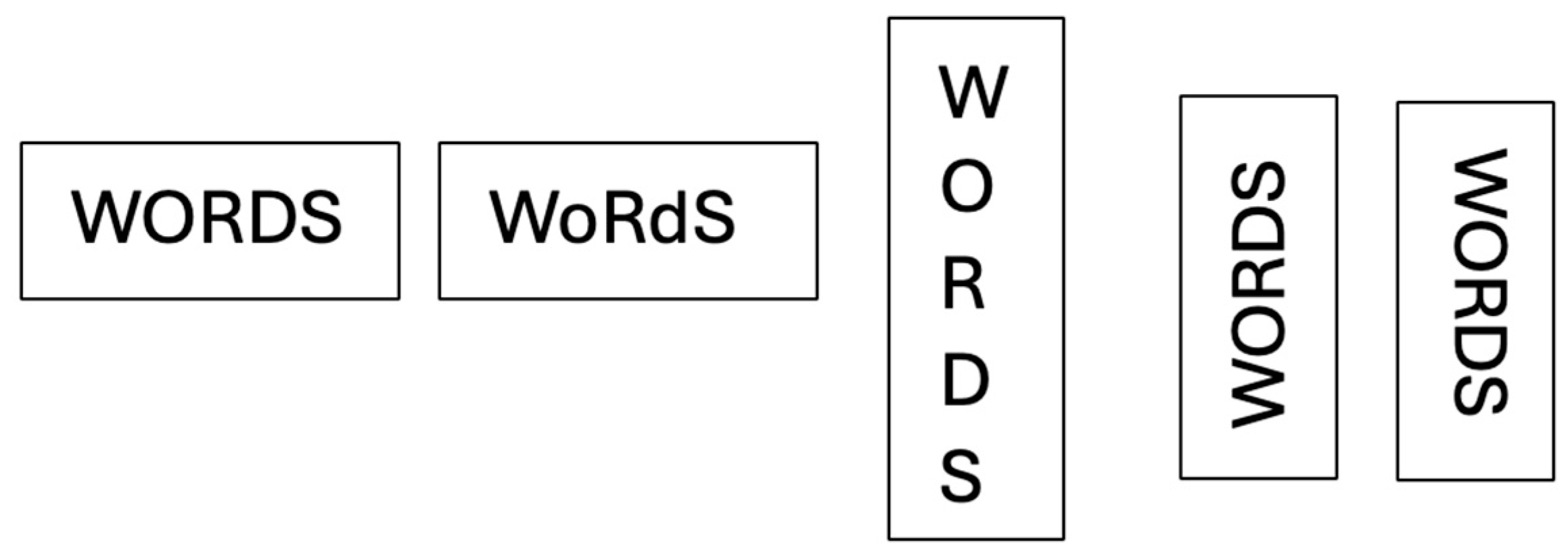Investigating the Impact of Presentation Format on Reading Ability in Posterior Cortical Atrophy: A Case Study
Abstract
1. Introduction and Clinical Significance
1.1. Attentional Effects in Word and Letter-in-String Naming: Non-Canonical Presentation Formats
1.2. The Impact of Case Mixing on Reading in Attentional Dyslexia
1.3. The Current Study: Attentional Dyslexia and Posterior Cortical Atrophy
2. Case Presentation
2.1. Experiment 1—Word Reading Across Canonical and Non-Canonical Presentation Formats
2.1.1. Materials and Procedure
2.1.2. Results
2.2. Experiment 2—Focusing on the Impact of Tilted Rotational Presentation on Single-Word Reading
2.2.1. Materials and Procedure
2.2.2. Results
2.3. Experiment 3—Naming of Letters in Strings in Non-Canonical Presentation Formats
2.3.1. Materials and Procedure
2.3.2. Results
3. Discussion
3.1. Format-Specific Effects and Strategy Use
3.2. Theoretical Contributions and Clinical Implications
Author Contributions
Funding
Institutional Review Board Statement
Informed Consent Statement
Data Availability Statement
Acknowledgments
Conflicts of Interest
References
- Hall, D.A.; Humphreys, G.W.; Cooper, A. Neuropsychological Evidence for Case-Specific Reading: Multi-Letter Units in Visual Word Recognition. Q. J. Exp. Psychol. Sect. A 2001, 54, 439. [Google Scholar] [CrossRef]
- Warrington, E.K.; Cipolotti, L.; McNeil, J.E. Attentional dyslexia: A single case study. Neuropsychologia 1993, 31, 871. [Google Scholar] [CrossRef]
- Coltheart, M.; Saunders, S.; Tree, J.J. Computational modelling of the effects of semantic dementia on visual word recognition. Cogn. Neuropsychol. 2010, 27, 101. [Google Scholar] [CrossRef]
- Morello García, F.; Difalcis, M.; Leiva, S.; Allegri, R.F.; Ferreres, A.R. Acquired surface dysgraphia and dyslexia in the semantic variant of primary progressive aphasia: A single-case study in Spanish. Aphasiology 2021, 35, 783–804. [Google Scholar] [CrossRef]
- Katori, M.; Tree, J.J.; Mousikou, B.; Coltheart, M.; Rastle, K. Prefixes repel stress during reading: Evidence from surface dyslexia. Cortex 2016, 74, 191–205. [Google Scholar] [CrossRef]
- Playfoot, D.; Billington, J.; Tree, J.J. Reading and visual word recognition ability in semantic dementia is not predicted by semantic performance. Neuropsychologia 2018, 111, 292. [Google Scholar] [CrossRef]
- Nickels, L.; Biedermann, B.; Coltheart, M.; Saunders, S.; Tree, J.J. Computational modelling of phonological dyslexia: How does the DRC model fare? Cogn. Neuropsychol. 2008, 25, 165–193. [Google Scholar] [CrossRef] [PubMed]
- Tree, J.J. Two types of phonological dyslexia—A contemporary review. Cortex 2007, 44, 698. [Google Scholar] [CrossRef] [PubMed]
- Tree, J.J.; Kay, J. Phonological dyslexia and phonological impairment: An exception to the rule? Neuropsychologia 2006, 44, 2861. [Google Scholar] [CrossRef] [PubMed]
- Uema, S.; Uno, A.; Hashimoto, K.; Sambai, A. A case of acquired phonological dyslexia with selective impairment of Kanji: Analysis of reading impairment mechanism using cognitive neuropsychological models for reading. Neurocase 2022, 28, 173–180. [Google Scholar] [CrossRef] [PubMed]
- Tree, J.J.; Perfect, T.J.; Hirsh, K.W.; Copstick, S. Deep Dysphasic Performance in Non-fluent Progressive Aphasia: A Case Study. Neurocase 2001, 7, 473. [Google Scholar] [CrossRef]
- Beaton, A.A.; Wyn Davies, N. Semantic errors in deep dyslexia: Does orthographic depth matter? Cogn. Neuropsychol. 2007, 24, 312–323. [Google Scholar] [CrossRef]
- Coltheart, M.; Rastle, K.; Perry, C.; Langdon, R.; Ziegler, J.C. DRC: A dual route cascaded model of visual word recognition and reading aloud. Psychol. Rev. 2001, 108, 204. [Google Scholar] [CrossRef] [PubMed]
- Shallice, T.; Warrington, E.K. The possible role of selective attention in acquired dyslexia. Neuropsychologia 1977, 15, 31–41. [Google Scholar] [CrossRef]
- Shallice, T.; Rosazza, C. Patterns of peripheral paralexia: Pure alexia and the forgotten visual dyslexia? Cortex 2006, 42, 892–897. [Google Scholar] [CrossRef]
- Ellis, A.W.; Young, A.W.; Anderson, C. Modes of word recognition in the left and right cerebral hemispheres. Brain Lang. 1988, 35, 254–273. [Google Scholar] [CrossRef] [PubMed]
- McCarthy, R.A.; Warrington, E.K. Cognitive Neuropsychology: A Clinical Introduction; Academic Press: Cambridge, MA, USA, 1990. [Google Scholar]
- Alexander, M.P.; Stuss, D.T.; Shallice, T.; Picton, T.W.; Gillingham, S. Impaired concentration due to frontal lobe damage from two distinct lesion sites. Neurology 2005, 65, 572. [Google Scholar] [CrossRef] [PubMed]
- O’Brien, B.A.; Mansfield, J.S.; Legge, G.E. The effect of print size on reading speed in dyslexia. J. Res. Read. 2005, 28, 332. [Google Scholar] [CrossRef]
- Paulesu, E.; Danelli, L.; Berlingeri, M. Reading the dyslexic brain: Multiple dysfunctional routes revealed by a new meta-analysis of PET and fMRI activation studies. Front. Hum. Neurosci. 2014, 8, 830. [Google Scholar] [CrossRef]
- Sigurdardottir, H.M.; Ólafsdóttir, I.M.; Devillez, H. Words as Visual Objects: Neural and Behavioral Evidence for High-Level Visual Impairments in Dyslexia. Brain Sci. 2021, 11, 1427. [Google Scholar] [CrossRef]
- Crutch, S.J.; Warrington, E.K. Foveal crowding in posterior cortical atrophy: A specific early-visual-processing deficit affecting word reading. Cogn. Neuropsychol. 2007, 24, 843–866. [Google Scholar] [CrossRef]
- Price, C.J.; Humphreys, G.W. Contrasting effects of letter-spacing in alexia: Further evidence that different strategies generate word length effects in reading. Q. J. Exp. Psychol. 1995, 48, 573–597. [Google Scholar] [CrossRef] [PubMed]
- Mendez, M.F.; Cherrier, M.M. The evolution of alexia and simultanagnosia in posterior cortical atrophy. Cogn. Behav. Neurol. 1998, 11, 76–82. [Google Scholar]
- Mendez, M.F.; Shapira, J.S.; Clark, D.G. “Apperceptive” alexia in posterior cortical atrophy. Cortex 2007, 43, 264–270. [Google Scholar] [CrossRef]
- Galton, C.J.; Patterson, K.; Xuereb, J.H.; Hodges, J.R. Atypical and typical presentations of Alzheimer’s disease: A clinical, neuropsychological, neuroimaging and pathological study of 13 cases. Brain 2000, 123, 484–498. [Google Scholar] [CrossRef] [PubMed]
- Elahi, F.M.; Miller, B.L. A clinicopathological approach to the diagnosis of dementia. Nat. Rev. Neurol. 2017, 13, 457. [Google Scholar] [CrossRef]
- Eden, G.F.; VanMeter, J.W.; Rumsey, J.M.; Zeffiro, T.A. The Visual Deficit Theory of Developmental Dyslexia. NeuroImage 1996, 4, S108–S117. [Google Scholar] [CrossRef]
- Vinckier, F.; Naccache, L.; Papeix, C.; Forget, J.; Hahn-Barma, V.; Dehaene, S.; Cohen, L. “What” and “Where” in Word Reading: Ventral Coding of Written Words Revealed by Parietal Atrophy. J. Cogn. Neurosci. 2006, 18, 1998. [Google Scholar] [CrossRef]
- Koriat, A.; Norman, J. Reading rotated words. J. Exp. Psychol. Hum. Percept. Perform. 1985, 11, 490. [Google Scholar] [CrossRef]
- Driver, J.; Baylis, G.C. Rotated letters and rotated words: A possible role for principal axes in visual word recognition. Mem. Cogn. 1995, 23, 560–568. [Google Scholar] [CrossRef]
- Byrne, M.D. Reading vertical text: Rotated vs. marquee. Proc. Hum. Factors Ergon. Soc. Annu. Meet. 2002, 46, 1633–1635. [Google Scholar] [CrossRef]
- Price, C.J.; Humphreys, G.W. Attentional dyslexia: The effect of co-occurring deficits. Cogn. Neuropsychol. 1993, 10, 569–592. [Google Scholar] [CrossRef]
- Starrfelt, R.; Petersen, A.; Vangkilde, S. Don’t words come easy? A psychophysical exploration of word superiority. Front. Hum. Neurosci. 2013, 7, 519. [Google Scholar] [CrossRef]
- Mayall, K.; Humphreys, G.W.; Olson, A. Disruption to word or letter processing? The origins of case-mixing effects. J. Exp. Psychol. Learn. Mem. Cogn. 1997, 23, 1275. [Google Scholar] [CrossRef]
- Besner, D.; Johnston, J.C. Reading and The Mental Lexicon: On the Uptake of Visual Information; MIT Press: Cambridge, MA, USA, 1989. [Google Scholar]
- Crutch, S.J.; Lehmann, M.; Schott, J.M.; Rabinovici, G.D.; Rossor, M.N.; Fox, N.C. Posterior cortical atrophy. Lancet Neurol. 2012, 11, 170–178. [Google Scholar] [CrossRef] [PubMed]
- Fumagalli, G.G.; Basilico, P.; Arighi, A.; Mercurio, M.; Scarioni, M.; Carandini, T.; Colombi, A.; Pietroboni, A.M.; Sacchi, L.; Conte, G.; et al. Parieto-occipital sulcus widening differentiates posterior cortical atrophy from typical Alzheimer disease. NeuroImage Clin. 2020, 28, 102453. [Google Scholar] [CrossRef]
- Dietz, C.D.; Albonico, A.; Tree, J.J.; Barton, J.J. Visual imagery deficits in posterior cortical atrophy. Cogn. Neuropsychol. 2023, 40, 351–366. [Google Scholar] [CrossRef] [PubMed]
- Kay, J.; Lesser, R.; Coltheart, M. Psycholinguistic Assessments of Language Processing in Aphasia (PALPA); Lawrence Erlbaum Associates: Hove, UK, 1992. [Google Scholar]
- Baylis, G.C.; Driver, J.; Baylis, L.L.; Rafal, R.D. Reading of letters and words in a patient with Balint’s syndrome. Neuropsychologia 1994, 32, 1273–1286. [Google Scholar] [CrossRef]
- Coslett, H.B.; Saffran, E. Simultanagnosia: To see but not two see. Brain 1991, 114, 1523–1545. [Google Scholar] [CrossRef] [PubMed]
- Parsons, L.M. Superior parietal cortices and varieties of mental rotation. Trends Cogn. Sci. 2003, 7, 515–517. [Google Scholar] [CrossRef]
- Gauthier, I.; Hayward, W.G.; Tarr, M.J.; Anderson, A.W.; Skudlarski, P.; Gore, J.C. BOLD activity during mental rotation and viewpoint-dependent object recognition. Neuron 2002, 34, 161–171. [Google Scholar] [CrossRef] [PubMed]
- Jordan, K.; Wüstenberg, T.; Heinze, H.-J.; Peters, M.; Jäncke, L. Women and men exhibit different cortical activation patterns during mental rotation tasks. Neuropsychologia 2002, 40, 2397–2408. [Google Scholar] [CrossRef] [PubMed]
- Lavidor, M.; Babkoff, H.; Faust, M. Analysis of standard and nonstandard visual word format in the two hemispheres. Neuropsychologia 2001, 39, 430–439. [Google Scholar] [CrossRef]
- Logothetis, N.K.; Pauls, J. Psychophysical and physiological evidence for viewer-centered object representations in the primate. Cereb. Cortex 1995, 5, 270–288. [Google Scholar] [CrossRef]
- Allen, A.; Tree, J.J.; Playfoot, D. Seeing things from different angles—Non-canonical orientation effects on visual word recognition reflect quantitative and not qualitative consequences. Q. J. Exp. Psychol. 2025. [Google Scholar]
- Marshall, J.C.; Newcombe, F. Patterns of paralexia: A psycholinguistic approach. J. Psycholinguist. Res. 1973, 2, 175–199. [Google Scholar] [CrossRef] [PubMed]
- Rayner, K.; Murphy, L.A.; Henderson, J.M.; Pollatsek, A. Selective attentional dyslexia. Cogn. Neuropsychol. 1989, 6, 357–378. [Google Scholar] [CrossRef]
- Friedmann, N.; Kerbel, N.; Shvimer, L. Developmental attentional dyslexia. Cortex 2010, 46, 1216–1237. [Google Scholar] [CrossRef]
- Nickels, L. Reading too little into reading?: Strategies in the rehabilitation of acquired dyslexia. Int. J. Lang. Commun. Disord. 1995, 30, 37–50. [Google Scholar] [CrossRef] [PubMed]



| Condition | Accuracy (Set A) | Accuracy (Set B) |
|---|---|---|
| Canonical—3 letters | 100 | 97.5 |
| Canonical—6 letters/5 letters | 95.0 | 97.5 |
| Marquee—3 letters | 92.5 | 90.0 |
| Marquee—6 letters/5 letters | 87.5 | 80.0 |
| Mixed case | 97.5 | 97.5 |
| Tilted—3 letters, clockwise | 27.5 | — |
| Tilted—6 letters, clockwise | 62.5 | — |
| Tilted—3 letters, counter | — | 47.5 |
| Tilted—6 letters, counter | — | 62.5 |
| Presentation Format | Clockwise | Anti-Clockwise | Total Accuracy |
|---|---|---|---|
| Canonical | 96 | 99 | 98 |
| Half tilt (50°) | 93 | 93 | 93 |
| Full tilt (90°) | 65 | 44 | 55 |
| Stimulus Type | Condition | 3 Items | 6 Items | Total Accuracy |
|---|---|---|---|---|
| Letters | Normal | 95 | 93 | 94 |
| Mixed Case | 90 | 78 | 84 | |
| Vertical | 90 | 78 | 84 | |
| Rotated | 40 | 20 | 30 | |
| Numbers | Normal | 100 | 70 | 85 |
| Vertical | 97 | 87 | 92 | |
| Rotated | 13 | 3 | 8 |
| Format | Letter Accuracy (%) | Reading Accuracy (%) | Difference (Reading—Letters) |
|---|---|---|---|
| Canonical | 100 | 97.5 | −4 |
| Mixed Case | 95.0 | 97.5 | −15 |
| Vertical | 92.5 | 90.0 | −23 |
| Rotated | 87.5 | 80.0 | −15 |
Disclaimer/Publisher’s Note: The statements, opinions and data contained in all publications are solely those of the individual author(s) and contributor(s) and not of MDPI and/or the editor(s). MDPI and/or the editor(s) disclaim responsibility for any injury to people or property resulting from any ideas, methods, instructions or products referred to in the content. |
© 2025 by the authors. Licensee MDPI, Basel, Switzerland. This article is an open access article distributed under the terms and conditions of the Creative Commons Attribution (CC BY) license (https://creativecommons.org/licenses/by/4.0/).
Share and Cite
Tree, J.J.; Playfoot, D.R. Investigating the Impact of Presentation Format on Reading Ability in Posterior Cortical Atrophy: A Case Study. Reports 2025, 8, 160. https://doi.org/10.3390/reports8030160
Tree JJ, Playfoot DR. Investigating the Impact of Presentation Format on Reading Ability in Posterior Cortical Atrophy: A Case Study. Reports. 2025; 8(3):160. https://doi.org/10.3390/reports8030160
Chicago/Turabian StyleTree, Jeremy J., and David R. Playfoot. 2025. "Investigating the Impact of Presentation Format on Reading Ability in Posterior Cortical Atrophy: A Case Study" Reports 8, no. 3: 160. https://doi.org/10.3390/reports8030160
APA StyleTree, J. J., & Playfoot, D. R. (2025). Investigating the Impact of Presentation Format on Reading Ability in Posterior Cortical Atrophy: A Case Study. Reports, 8(3), 160. https://doi.org/10.3390/reports8030160






